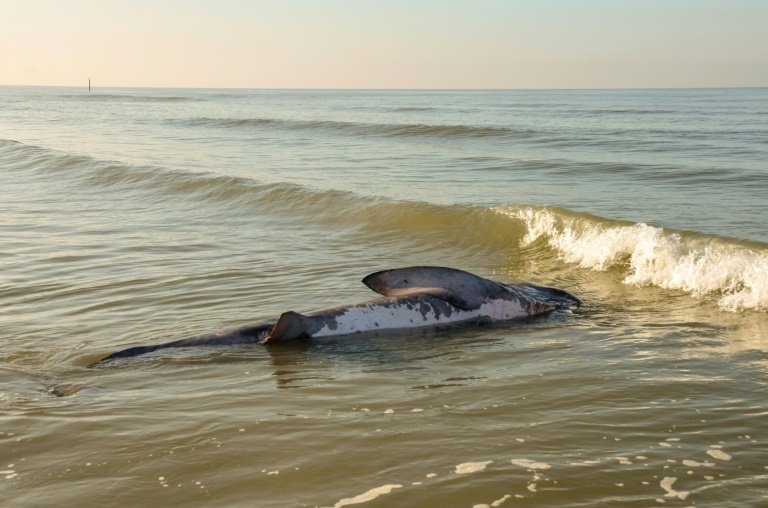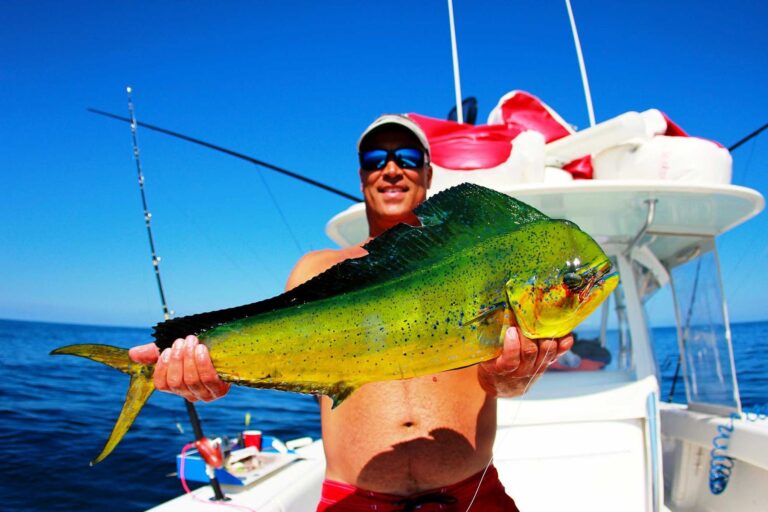There are various types of deep sea fish, including lanternfish, anglerfish, gulper eel, and viperfish. These fish have adapted to the dark and cold environment of the deep sea, and many of them have unique characteristics to help them survive.
The deep sea is one of the most fascinating and mysterious habitats on earth. It is home to a diverse range of creatures, including deep sea fish. These fish are adapted to survive in the cold, dark, and high-pressure environment of the deep sea.
There are various types of deep sea fish, each with unique physical characteristics and adaptations. From the bioluminescent lanternfish to the monstrous gulper eel and the terrifying viperfish, these creatures have captivated scientists and ocean enthusiasts alike. In this article, we will explore the different types of deep sea fish and their fascinating adaptations.

Credit: mashable.com
Types Of Deep Sea Fish: An Introduction
Deep sea fish are a fascinating group of creatures that often inhabit the darkest depths of the ocean. These fish are defined as those that live in waters deeper than 200 meters, where sunlight can’t penetrate and the pressure is extreme.
Despite these harsh conditions, deep sea fish survive and thrive, displaying a range of unique adaptations that allow them to survive in this extreme environment. In this post, we’ll be discussing the different types of deep sea fish, starting with an introduction to the subject.
Definition Of Deep Sea Fish
Deep sea fish are characterized by their habitat, living in the deep, dark, and often freezing ocean depths. These fish must contend with an extremely high pressure environment, low to no sunlight, and temperatures that can fluctuate rapidly. They are typically recognized as those that live below the epipelagic zone (the top 200 meters of ocean) and inhabit the mesopelagic, bathypelagic, abyssopelagic, and hadopelagic zones.
Some of the most iconic deep sea fish include the anglerfish, gulper eel, and lanternfish.
Importance Of Deep Sea Fish
Deep sea fish play an essential role in marine ecosystems, despite being relatively understudied compared to their shallow water counterparts. They are an essential food source for larger predators and are known to migrate to shallower waters to spawn and feed.
In addition, deep sea fish can provide important insights into how organisms adapt and evolve to extreme environments. They also have potential pharmaceutical applications, with their unique biology offering up promising new drugs for human use. In short, studying deep sea fish is critical for understanding both the ecology and evolution of the ocean’s depths.
Overall, understanding the different types of deep sea fish is essential for appreciating the diverse, and often bizarre, inhabitants of the deep ocean. From survival strategies to ecological importance, exploring this fascinating group of animals offers up a wealth of insights into the world beneath the waves.
Bioluminescent Deep Sea Fish
Types Of Deep Sea Fish: Bioluminescent Deep Sea Fish
Deep sea fish are unique creatures that live in the harsh conditions of the deep ocean. One of the most fascinating types of deep sea fish is the bioluminescent fish. These fish are known for their ability to produce light through a chemical reaction that occurs within their bodies.
In this section, we will explore the fascinating world of bioluminescent deep sea fish.
Definition Of Bioluminescence
Bioluminescence is the ability of living organisms to produce light through a chemical reaction. In the case of bioluminescent deep sea fish, this chemical reaction occurs within special cells called photophores, which are located on the fish’s body. When these cells are stimulated, they produce light that can range in color from red to green to blue.
Reasons For Bioluminescence In Deep Sea Fish
The ability to produce light has many advantages for deep sea fish. Some of the main reasons that deep sea fish use bioluminescence include:
- Attracting prey: Bioluminescent deep sea fish can use their light to attract smaller fish, plankton, and other organisms that they feed on.
- Camouflage: Some deep sea fish use bioluminescence to match the light levels of their surroundings, making them more difficult to spot by predators.
- Communication: Bioluminescent deep sea fish can use their light to communicate with members of their own species. For example, anglerfish use a glowing lure to attract mates, while some lanternfish use their light to signal to others in their school.
Different Types Of Bioluminescent Deep Sea Fish
There are many different types of bioluminescent deep sea fish, each with their unique features and characteristics. Some of the most well-known bioluminescent deep sea fish include:
- Anglerfish: These fish are famous for their glowing lure, which they use to attract prey.
- Lanternfish: These are some of the most common types of bioluminescent deep sea fish. They typically emit a blue-green light and are found throughout the world’s oceans.
- Dragonfish: These fish have a row of light-producing organs called photophores along their bellies, which they use to attract prey.
- Comb jellies: These creatures are not actually fish, but they are bioluminescent and found in the deep ocean.
Bioluminescent deep sea fish are a fascinating group of creatures that have evolved to thrive in the extreme conditions of the deep ocean. Their ability to produce light through a chemical reaction has many advantages, including attracting prey, camouflage, and communication.
With their unique features and characteristics, bioluminescent deep sea fish continue to captivate and intrigue scientists and deep sea enthusiasts alike.
Features And Characteristics Of Bioluminescent Deep Sea Fishes
Types of deep sea fish: features and characteristics of bioluminescent deep sea fishes
The deep sea is home to some of the most interesting and unique animals on earth. Among them are bioluminescent deep sea fishes, fishes that can produce their light, making them glow in the dark. We will discuss the key characteristics and features of these creatures that help them survive in their environment.
How Bioluminescent Deep Sea Fish Survive In Their Environment
Bioluminescent deep sea fish have evolved unique characteristics that allow them to thrive in the dark depths of the ocean. Some of these features include:
- Bioluminescence: Bioluminescent deep sea fish produce their light, allowing them to camouflage or lure prey. This feature helps them to attract prey, distracting or stunning them, defend themselves, or confuse predators.
- Large mouth: They have a large mouth that can expand to several times their body size, allowing them to swallow prey bigger than themselves.
- Photo organs: Photo organs filled with bacteria allow bioluminescent deep sea fish to create light and appear larger than they are. They also use photo organs to communicate and adapt to their environment, camouflage, and lure prey.
- Transparent skin: Their transparent skin provides camouflage, making it difficult for predators to spot them from below and allowing them to hide in plain sight. Transparent skin also enables them to reflect light, helping them blend in with their surroundings.
- Slow metabolism: Bioluminescent deep sea fish have a slow metabolism, allowing them to survive in an environment where food is scarce. With this adaptation, they can survive even months without eating.
Bioluminescent deep sea fish have unique features and adaptations that help them to survive and thrive in their environment. With these characteristics, they can hunt, evade predators, and communicate with others effectively. These fascinating creatures are an excellent example of how evolution can produce remarkable and unique survival strategies in animals.
Bizarre Deep Sea Fish
If you think you know what “bizarre” means, wait till you hear about the deep-sea fish lurking in the murky depths. These creatures are a testament to how vast and strange our world is. From creepy eyes to strange shapes, these creatures are about to awe you in every way possible.
Definition Of Bizarre Deep Sea Fish
Bizarre deep sea fish are species that are not only unusual in shape but also have unique characteristics that set them apart from other fish that inhabit shallower waters that are more familiar to humans. They are found in the far reaches of the ocean, where it is dark, cold and the atmospheric pressure can be extreme.
The unique features of these fish have evolved over time to allow them to survive in these hostile environments.
The Strangest Deep Sea Fish Ever Discovered
The deep sea is home to some of the most unusual species found on earth. The anglerfish, for instance, has a lure that hangs in front of its mouth, which it uses to attract prey. The deep sea hatchetfish has a body that is almost transparent, making it almost invisible to predators.
The fangtooth has teeth that are so large that they are too big to fit in its mouth. It has to open its jaws at a 180-degree angle to eat its prey. Perhaps the most bizarre of all is the football fish.
It has a bioluminescent light that hangs from its head, which it uses to attract prey, and its oversized head is filled with sharp teeth.
The Unique Characteristics Of Bizarre Deep Sea Fish
Bizarre deep sea fish are unique in so many ways. Here are some of the characteristics that set them apart:
- Bioluminescence: Many deep sea species have the ability to produce light, which they use for communication or mating.
- Gigantism: Faced with a lack of prey, some fish evolve to be huge so that they can eat other fish that are smaller than themselves.
- Invisibility: Transparency is a common adaptation in deep-sea fish, allowing them to avoid being seen by predators.
- Lack of eyes: Some species living so deep in the ocean have no eyes at all.
- Sharp teeth: Many deep sea fish have evolved teeth that are disproportionately large to their bodies, allowing them to catch prey larger than themselves.
- Long tentacles: Tentacles are important sensory organs for deep-sea species, used both to navigate and hunt. Some species have tentacles that are longer than their bodies.
If you want to experience the bizarre world of deep-sea fish for yourself, consider going on a deep-sea diving expedition. You never know what strange and unfamiliar species you may encounter on your underwater adventure!
Behavior And Adaptations Of Bizarre Deep Sea Fish
Deep sea fish are some of the most bizarre and fascinating creatures in the world. They inhabit some of the deepest and darkest parts of the ocean, where the conditions are extreme and the pressure is immense. Let’s take a closer look at how these strange creatures behave and adapt in their unique environment, focusing on their behavior and adaptations.
How Bizarre Deep Sea Fish Thrive In Their Ecosystems
Deep sea fish are uniquely adapted to thrive in their harsh ecosystems. Here are some key points to consider:
- Many deep sea fish have large eyes that are adapted to low light environments. Some even have eyes that are so large that they take up most of their heads!
- Some of these fish have bioluminescent organs that help them to attract prey or communicate with each other in the darkness.
- Many deep sea fish have long, slender bodies that allow them to move more efficiently through the water. Some even have elongated jaws or teeth that are adapted for catching prey in their deep sea environment.
- Deep sea fish have adapted to survive in cold temperatures and high pressures that would be fatal to most other creatures.
- Some deep sea fish have the ability to produce antifreeze proteins, which help them to avoid freezing in the cold waters of the deep sea.
Behavior Of Bizarre Deep Sea Fish
Deep sea fish exhibit some of the most unique behaviors found in the animal kingdom. Here are some key points to consider:
- Many deep sea fish are opportunistic feeders, eating whatever prey they come across. Others have highly specialized diets, feeding only on specific types of prey.
- Some deep sea fish have evolved the ability to use their bioluminescent organs to lure prey towards them. This is known as bioluminescent baiting.
- Many deep sea fish are able to survive for long periods of time without eating, which is essential in an environment where food is scarce.
- Some deep sea fish are able to produce glowing clouds of mucus that help them to avoid predators.
- Deep sea fish often form symbiotic relationships with other organisms, such as bacteria or other fish, in order to survive in their challenging environment.
Deep Sea Fish For Conservationists
Definition Of Conservation
Conservation refers to the act of protecting and preserving the environment, wildlife, and natural resources for the benefit of future generations. Deep-sea fish conservation involves protecting deep-sea fish and their habitats from destructive human activities such as overfishing and deep-sea mining.
The Importance Of Conservation For Deep Sea Fish
Although deep-sea fish are not as popular as other fish species, they play a vital role in the ocean’s ecosystem. The conservation of these fish is essential because:
- Deep-sea fish are slow-growing and late-maturing, making them highly vulnerable to overfishing.
- Some deep-sea fish have low reproductive rates, making it difficult for their populations to recover from overfishing.
- Deep-sea fish are an important link in the ocean’s food chain and their conservation is necessary to maintain the balance of the marine ecosystem.
Threats To Deep Sea Fish And Their Ecosystems
Deep-sea fish face numerous threats, including:
- Overfishing: Overfishing is the most significant threat to deep-sea fish. Unregulated and unsustainable fishing practices can lead to the rapid depletion of deep-sea fish populations, resulting in negative impacts on the ocean’s ecosystem.
- Deep-sea mining: Deep-sea mining involves extracting minerals from the ocean floor. The process involves disturbing the seafloor and destroying habitats, which can lead to the displacement of deep-sea fish.
- Climate change: Climate change is altering the ocean’s chemistry and temperature, which can have significant impacts on deep-sea fish and their habitats.
Conservationists play an essential role in maintaining the health and sustainability of the ocean’s ecosystem. By promoting responsible fishing practices, advocating for deep-sea protected areas, and raising awareness about the importance of conservation, conservationists can help protect deep-sea fish and their habitats for future generations.
Conclusion
The deep sea is a mysterious and fascinating world filled with a wide variety of fish that have adapted to living in this extreme environment. From the anglerfish to the viperfish, each species has unique characteristics that allow them to survive in the harsh conditions of the deep sea.
Learning about these creatures can help us better understand the complexity and diversity of the ocean. By protecting and conserving these deep-sea ecosystems, we can ensure that these incredible fish continue to thrive in their natural habitats. So whether you’re a marine biologist or an avid fish enthusiast, there is always something new to discover and appreciate in the amazing world of deep sea fish.



